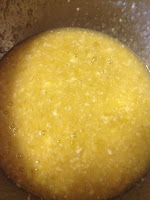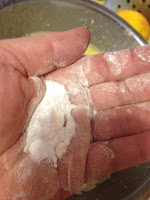 |
| Home Baked Bread |
Bread is the staff of life and a truly portable food. Born of flour and a little micro-organism yeast. Yeast is found everywhere in the air, on fruits, and on our bodies. How man came to understand and use yeast is unknown. A reasonable guess would be that beer was the first use for yeast. Ancient man could have left a mixture of wheat and water too long and when the carbon dioxide bubbles and alcohol formed they created an interesting fragrance and the curious human drank it. There is even a theory that beer is the reason for civilization. Then, tired of eating unleavened bread, someone dumped more flour into the beer mash and baked the result - bread was born.
The economics of bread is as astounding as the simplicity of the recipe. Grocery Store bread costs $2.75 for a 2 pound loaf, flour is around $2.59 for 5 pounds that will make 5 pounds of bread. If your family goes through 2 loaves of bread a week your yearly bread budget is $286. If you made your bread, you would cut that cost down to $108. Not only would you save money but the bread is better tasting and has no additives.
Bread is made from 4 basic ingredients: Wheat Flour, Salt, Yeast, Water. Simple and tasty. You will notice there is no sugar in basic bread. That's because the starch in flour will break down into simple sugar and feed the yeast. This happens rapidly. Salt retards the yeast growth a little and gives bread a finer texture and better flavor. Simple! The yeast I recommend be bought in 1 lb bulk packages of dry-active yeast and not the little envelopes that tend to contain yeast that is not interested in rising. Yeast should be stored in the freezer to keep it alive and active.
Now to make the bread. 5 minutes, I promise.
One 5 quart ice cream pail or any 5 quart container with a lid
From the tap - 3 cups hot water
Dump in 1 T yeast and 1T salt
Dump in 6 1/2 cups of flour
Stir with a spoon to moisten all the flour - dough will be wet
 |
| The Bread Dough looks lumpy but is completely moistened |
 |
| After the dough has been able to rise - it is double in bulk |
 |
| punched down dough, you can see the finger prints! |
Snap on the lid and stow the dough in the refrigerator overnight. The dough will stay good for 3 days in the refrigerator so no hurry.
 |
| Safe in the ice cream bucket and ready for the refrigerator. |
 |
| Refrigerated dough has a silky texture |
When ready to bake: you will need 2 one pound bread pans or one 2 pound bread pan
Grease the pans
Wet hands and pull out the dough and shape it into loaf shapes (dough is cold and never touches anything but your hands and the bread pan.) and place in pan(s), Grease the top of the loaves to prevent them from drying out. Let them rise about an hour.
 |
| dough just peeps over the edge of the bread pan |
Pop them into a pre-heated over at 350 degrees for 40 minutes. When done, the loaves will be golden brown and sound hollow when thumped. Turn the pans on their side to cool. Cooling on the side allows the bread to come free from the pan and it also changes the direction of the carbon dioxide bubbles in the bread ensuring even cooling.
 |
| Golden loaves rest on their sides to cool |
Substitutions: (loaves will require more rising time and will be denser )
2 Cup rye flour for 2 Cup white flour + 2 tablespoons of molasses
1 Cup wheat germ for 1 Cup white flour + 2 tablespoons of molasses
1 Cup Oatmeal for 1 Cup white flour
3 Cups whole wheat flour for 3 Cups white flour







